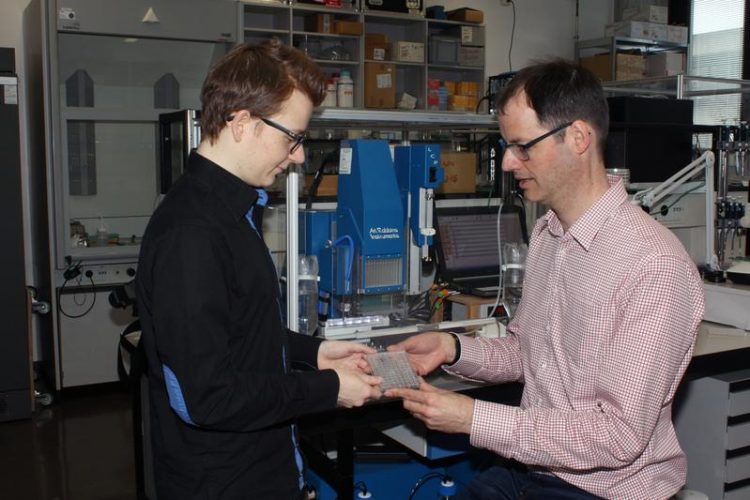New Method Speeds Up Development of Medication

In the laboratory of Bernhard Spingler (r.), trainee Philipp Nievergelt (l.) made an important contribution to determine the crystal structures of organic salts faster and easier. UZH
One of the key steps in developing new drugs is determining the atomic structure of its biologically active substances. This generally involves performing X-ray analyses of single crystal structures to determine the ingredient’s detailed three-dimensional set-up. However, growing suitable single crystals is often a complex and time-consuming process.
Determining crystal structures more quickly and efficiently
A research group headed up by Bernhard Spingler, professor at the Department of Chemistry of the University of Zurich, has now modified a method that had previously been used exclusively for the crystallization of proteins, and successfully applied it to organic salts. The team was able to determine the crystal structures of several organic salts with significantly less time and effort. “As organic salts make up about 40 percent of all active pharmaceutical ingredients, this new method can greatly speed up the development of drugs,” says Spingler.
Simplified screening of organic salts
The generation of solid salts of organic molecules is a key step in developing certain pharmaceutical ingredients. The positively and negatively charged particles that make up organic salts determine their properties, such as their solubility, crystal shape, ability to absorb water, melting point, and stability. The search for the ideal negatively charged anion to match the salt’s positively charged cation has until now been a very resource-intensive process.
Thanks to the semi-automatic combination of ion exchange screening and vapor diffusion for crystallization, this is not only done quicker and at lower costs. “We can now also determine the structures of the salt combinations directly after screening, since doing so only requires only very small amounts,” adds crystallography expert Spingler.
Trainee achieves breakthrough
The breakthrough in developing the novel method was achieved by Philipp Nievergelt, a trainee who had spent 10 months in Bernhard Spingler’s lab after graduating from Gymnasium. The successful junior researcher is listed as first author of the study and is now four semesters into his business chemistry studies at UZH. “The traineeship got me excited about lab work and encouraged me to continue doing research,” explains Nievergelt.
Literature:
Philipp P. Nievergelt, Martin Babor, Jan Čejka, Bernhard Spingler. A high throughput screening method for the nano-crystallization of salts of organic cations. Chemical Science. March 12, 2018. DOI: 10.1039/C8SC00783G
Contact:
Prof. Bernhard Spingler, PhD
Department of Chemistry
University of Zurich
Phone +41 44 635 46 56
E-mail: spingler@chem.uzh.ch
http://www.media.uzh.ch/en/Press-Releases/2018/crystal-structures-organic-salts….
Media Contact
All latest news from the category: Life Sciences and Chemistry
Articles and reports from the Life Sciences and chemistry area deal with applied and basic research into modern biology, chemistry and human medicine.
Valuable information can be found on a range of life sciences fields including bacteriology, biochemistry, bionics, bioinformatics, biophysics, biotechnology, genetics, geobotany, human biology, marine biology, microbiology, molecular biology, cellular biology, zoology, bioinorganic chemistry, microchemistry and environmental chemistry.
Newest articles

A new look at the consequences of light pollution
GAME 2024 begins its experiments in eight countries. Can artificial light at night harm marine algae and impair their important functions for coastal ecosystems? This year’s project of the training…

Silicon Carbide Innovation Alliance to drive industrial-scale semiconductor work
Known for its ability to withstand extreme environments and high voltages, silicon carbide (SiC) is a semiconducting material made up of silicon and carbon atoms arranged into crystals that is…

New SPECT/CT technique shows impressive biomarker identification
…offers increased access for prostate cancer patients. A novel SPECT/CT acquisition method can accurately detect radiopharmaceutical biodistribution in a convenient manner for prostate cancer patients, opening the door for more…





















